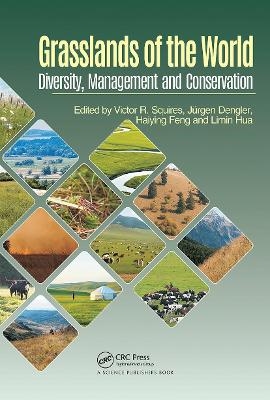
Grasslands of the World
CRC Press (Verlag)
978-0-367-78093-7 (ISBN)
This book begins with a brief account of the extraordinary sequence of events that led to emergence of grasslands as major vegetation formations that now occupy some of the driest and hottest and the highest and coldest on earth as well as vast steppes and prairies in more temperate climes. It is the story of grasses successfully competing with forests and woodlands, aided and abetted by grazing herbivores and by humans and their use of fire as a tool. It is a story of adaptation to changing climates and the changing biophysical environments.
A major focus of the book is the Palaearctic biogeographic realm that extends over some 45 million km² and thus more than 1/3 of the terrestrial ice-free surface on Earth. It comprises extensive grasslands of different types and origin, which can be subdivided into (1) natural grasslands with (1a) steppes (climatogenic in dry climates), (1b) arctic-alpine grasslands (climatogenic in cold climates) and (1c) azonal and extrazonal grasslands (pedogenic and topogenic) as well as (2) secondary grasslands created and sustained by human activities, such as livestock grazing, mowing or burning. Grasslands of the Palaearctic do not only form a major basis for the agriculture of the region and thus its food supply, but are also crucial for other ecosystem services and host a supra proportional part of the realm’s plant and animal diversity. To reflect that suitability of grasslands for biodiversity strongly depends on their state, we apply the term High Nature Value grassland to those natural grasslands that are not degraded (in good state) and those secondary grasslands that are not intensified (semi-natural).
The situation in a variety of countries where grasslands are evolving under the influence of global climate change is also considered. Case studies are presented on Southern Africa, Eastern Africa, India, China, South America, North America and Australia.
The concluding chapter examines a set of themes arising from the chapters that make up the bulk of this book. The following provide a focus: recent history of grassland biomes – brief recap of current thinking and recent trends with special reference to dry grasslands in the Palearctic regions; the current status of grasslands and germplasm resources (biodiversity) – an overview; management systems that ensure sustainability; how to recover degraded grasslands; socio-economic issues and considerations in grassland management; the impacts of environmental problems in grasslands such as future climate change and intensification and the problems/prospects facing pastoralists and other grassland-based livestock producers.
Dr. Victor Squires is an Australian who as young man studied botany and rangeland ecology. He has a PhD in Rangeland Science from Utah State University, USA and is former Dean of the Faculty of Natural Resource Management at the University of Adelaide, Australia where he worked for 15 years after a 22 year career in Australia’s CSIRO. Since retirement from the University of Adelaide, Dr. Squires was a Visiting Fellow in the East West Center, Hawaii and is currently an Adjunct Professor in the University of Arizona, Tucson and at the Gansu Agricultural University, Lanzhou, China. He has been a consultant to World Bank, Asian Development, and various UN agencies in Africa, China, Central Asia, and the Middle East. He is author of over 130 papers in refereed journals and numerous invited chapters and is author/editor of 11 books. Dr. Squires was awarded both the 2008 International Award and Gold Medal for International Science and Technology Cooperation and the Friendship Award in 2011 by the government of China; the Gold Medal is the highest award for foreigners. In 2015, Dr. Squires was honored by the Society for Range Management (USA) with an Outstanding Achievement Award.
A short history of grassland utilization and its significance to humans. Palaearctic Grasslands in Transition: Overarching Patterns and Future Prospects. Grasslands of Western and Northern Europe – between Intensification and Abandonment. Grasslands, their Threats and Management in Eastern Europe. Land use of natural and secondary grasslands in Russia. Grasslands of the Mediterranean Basin and the Middle East and their management. Grasslands of Kazakhstan and Middle Asia: the ecology, conservation and use of a vast and globally important area. Grasslands of China and Mongolia: spatial extent, land use and conservation. Grassland biodiversity in Japan: threats, management and conservation. Rangelands/grasslands of India: current status and future prospects. North American Grasslands and Biogeographic Regions. Southern African Grassland in an era of Global Change. Grasslands of Eastern Africa: problems and prospects. Grasslands in South America: nature and extent in relation to provision of ecosystem services. Grasslands in Australia - an overview of current status and future prospects. Climatic change and its impact on grassland-based livelihoods in China. Future Prospects of Grasslands and Ranching on the North American Scene. What future for the world’s grasslands under global (not only climate) change? Key word and Index.
| Erscheinungsdatum | 06.04.2021 |
|---|---|
| Verlagsort | London |
| Sprache | englisch |
| Maße | 178 x 254 mm |
| Gewicht | 453 g |
| Themenwelt | Naturwissenschaften ► Biologie ► Ökologie / Naturschutz |
| Weitere Fachgebiete ► Land- / Forstwirtschaft / Fischerei | |
| ISBN-10 | 0-367-78093-3 / 0367780933 |
| ISBN-13 | 978-0-367-78093-7 / 9780367780937 |
| Zustand | Neuware |
| Haben Sie eine Frage zum Produkt? |
aus dem Bereich


